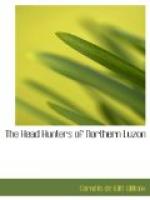[21] According to De Morga (p. 196, Retana’s edition), the anito was a representation of the devil under horrible and frightful forms, to which fruits and fowl and perfumes were offered. Each house had and “made” (or performed) its anitos, there being no temples, without ceremony or any special solemnity. “This word,” says Retana, “is ordinarily interpreted ‘idol,’ although it has other meanings. There were anitos of the mountains, of the fields, of the sea. The soul of an ancestor, according to some, became embodied as a new anito, hence the expression, ‘to make anitos.’ Even living beings, notably the crocodile, were regarded as anitos and worshiped. The anito-figura, generally shortened to anito, ... was usually a figurine of wood, though sometimes of gold.” (Glossary to his edition of De Morga, pp. 486-487.)
“The anito of the Philippines is essentially a protecting spirit.” (F. Jagor, “Travels in the Philippines,” p. 298. English translation, London, Chapman & Hall, 1875; originally published in Berlin. 1873, “Reisen in den Philippinen,” Weidmannsche Buchhandlung.)
“The religion of the islands, what may be called the true religion of Filipinos, consisted of the worship of the anitos. These were not gods, but the souls of departed ancestors, and each family worshipped its own, in order to obtain their favorable influence.” (Pardo de Tavera, “Resena Historica de Filipinas,” Manila, 1906.)
[22] Apo means “lord, master.” In the mountains every American is called apo. “Sir” in Tagalo is po, and the highest mountain of the Archipelago is named Apo. The native word for fire in these parts is something like apo. To distinguish Mr. Forbes from other apos. he was called apo apo in communicating with the natives.
[23] Now frequently called ub-ub, i.e., “spring,” in the Ifugao country; a change of name due to Gallman.
[24] See De Morga, “Sucesos,” etc., p. 184, Retana’s edition, and Retana’s note on the passage; see also Jagor, “Travels,” etc., p. 162 et seq.
[25] Runo is a stiff reed grass growing to several feet, the mountain cousin of the cogon of the plains.
[26] The Princesa was the only fat person we saw in the mountains: apparently these Highlanders all grow thin with age, and wrinkled from head to foot.
[27] See Philippine Journal of Science, July, 1909, for Villaverde’s account of the Ifugaos of Kiangan, translated and edited by Worcester, with notes and an addendum by Major Case, of the Constabulary.
[28] Gallman says they also carry their spears point down to cause the enemy’s spears to miss.—C. De W.W.




